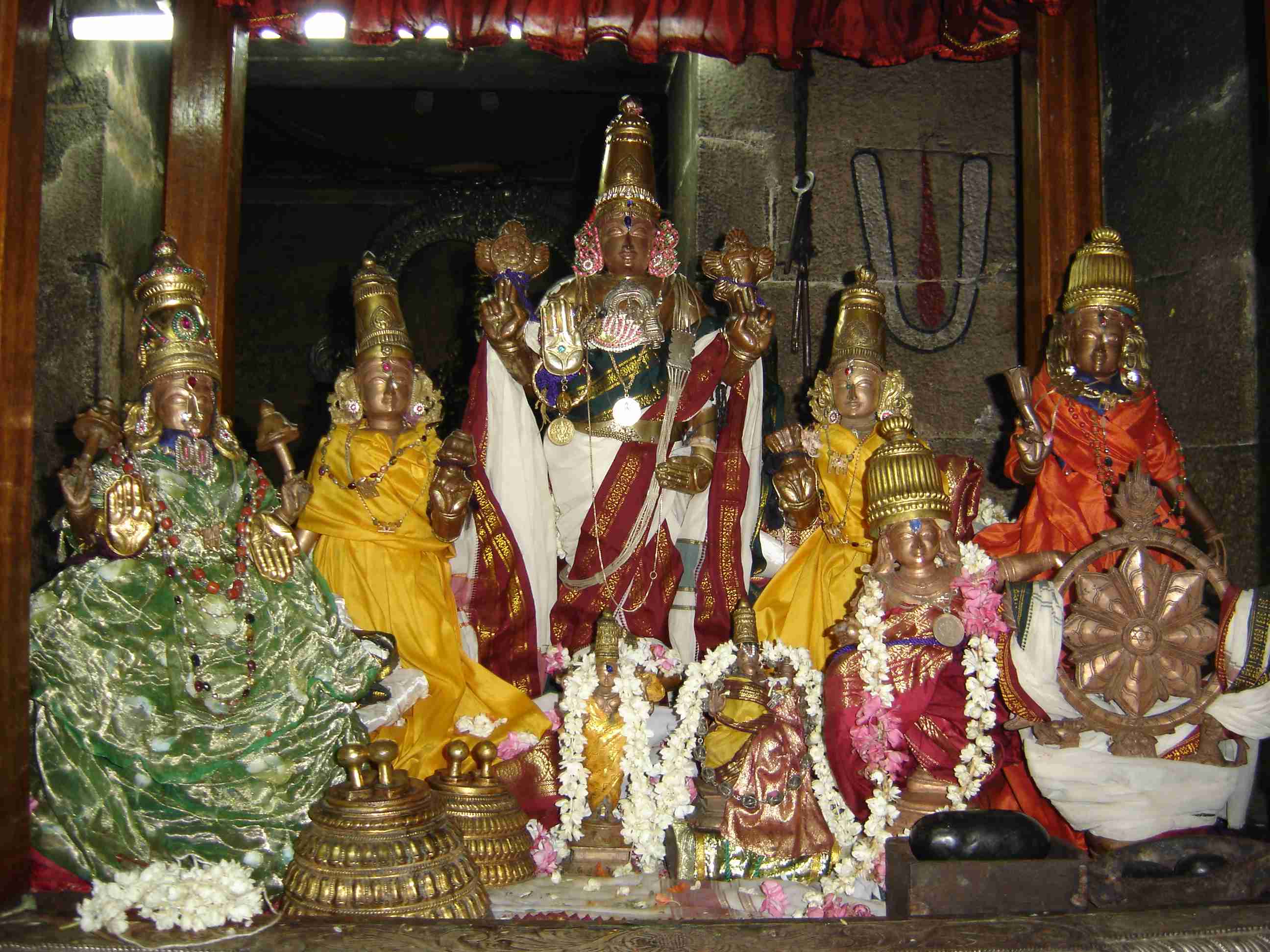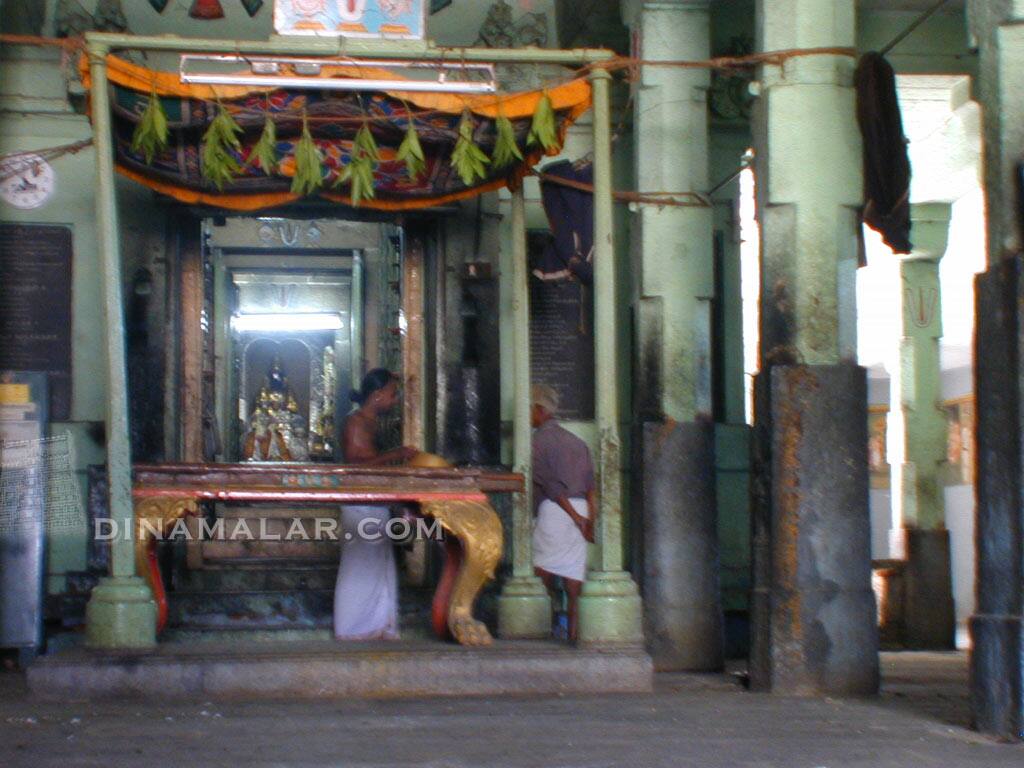GITA 11.21
 |
| SWAMI MANAVALA MAMUNIGAL |
In Aippasi [ஐப்பசி]month and in star Moolam [மூலம்], was born Vishatavaksikhamani Swami Manavala Mamunigal. He is praised as the last Acharya in Sri Vaishnava Guru parampara [Acharyas' lineage]. He was born in the South, Azhvar Tirunagari. His Acharya was Swami Tiruvaimozhi Pillai [திருவாய்மொழிபிள்ளை ]. Since he was deeply interested in Nammalwar's Tiruvaimozhi, he was called Swami Tiruvaimozhi Pillai. Also, Swami Tiruvaimozhi Pillai was born in the same Vaikasi [வைகாசி] month and in the same Visaka [விசாகம் ] star [as Nammalwar]. Though the Vedas in Sanskrit had great eminence, these Two Acharyas wanted to spread the Dravida Veda, Tiruvaimozhi, and also the other 3000 verses in Nalayira Divya Prabhandam to be propagated and spread all over for recitation in temples. Swami Manavala Mamunigal stayed in this Kshetram Tiruvekkha for an year. His Acharya Swami Tiruvaimozhi Pillai had instructed him to carry out an order. Sri Bhashyam penned by Swami Ramanuja was a commentary on Vedanta and was in Sanskrit. It was a detailed explanation of Brahmasootra by Veda Vyasa. All Acharyas learnt Sri Bhashyam and taught others. But Swami Tiruvaimozhi Pillai desired that Swami Manavala Mamunigal should teach Sri Bhashyam only once and afterwards throughout his life he should be involved in Tiruvaimozhi in Tamil. He, therefore, ordered his disciple to teach only once Sri Bhashyam and afterwards he should concentrate on Tiruvaimozhi in the easily understandable Tamil language. Accordingly, Swami Manavala Mamunigal arrived at Tiruvkkha and taught Sri Bhashyam for one year.
 |
| PLACE FROM WHERE SWAMY MANAVALA MAMUNIGAL TAUGHT SRIBHASHYAM |
 |
| SRIBHASHYAM KALAKSHEPAM |
Today's [24th October 2008] lecture is from the place, where he taught. As we enter we find on the left Sri Andal's sannidhi. Between this sannidhi and Periyalwar's mandapam, he was teaching. While in this place, he got installed Swami Pillai Lokacharya's [his Acharya's Acharya] idol here.
 |
| SWAMY PILLAI LAKACHARYA |
We can worship Swami Pillai Lokacharya - author of Ashtadisa Grantha and Sri Vachana Bhooshanam, very sacred books. He lived a bachelor and so his idol has white robes. As a bachelor through out his life, he elaborately explained the interpretations of Tirumantram [Ashtaksharam], Dwayam and Charama sloka, found in Gita. Next, we worship the idol of Swami Manavala Mamunigal in saffron robes as he was a sanyasi [ascetic]. He is holding Tridanda. He was born in star Moolam and we can say because of him [moolam in Tamil also means cause] Tamil Prabhandam was enlivened. We have to see how intimately the Lord is connected with the Azhvars' pasurams, which Swami Manavala Mamunigal propagated. The First Three Alwars referred to as Mudhal Azhvargal, were respectfully called as in kavi padum parama kavigal [இன் கவி பாடும் பரம கவிகள்]. They praised the Lord in sweet Tamil. All the pasurams of them were in venba [வெண்பா] style [a class of poetry]. Tirumazhisai Alwar is associated with this Kshetram and one can say the Lord of this place got the name Sri Sonnavannam Perumal, because of him. This place was ruled by a King, who desired to be praised by Tirumazhisai Alwar. But Alwar never sang in praise of mortals. Alwar had a disciple Kanikannan [கணிகண்ணன்]. King tried to get Alwar to praise him, through Kanikannan, who refused. The King ordered Kanikannan to be exiled. Alwar thought that because of him, his disciple was to move out of the place, and so Alwar also decided to follow suit. Alwar saw Sri Yatoktakari reclining on the serpent and he immediately told ' kanikannan poginran; kamaru poonkachi manivanna! nee kidakka venda! Sennapulavanum poginren; neeyum unran pai nagappai suruttik kol [கணிகண்ணன் போகின்றான்; காமருபூங்கச்சி மணிவண்ணா! நீ கிடக்க வேண்டா! செந்நாப் புலவனும் போகின்றேன்! நீயும் உன்றன் பைந்நாகப் பாய் சுருட்டிக் கொள் !]' - Alwar said, " Kanikannan is going [out of Kanchi, on the orders of King]. Oh! Manivanna! Fluent poet [Tirumazhisai Alwar] am also going. [So] You [the Lord, Sri Yatoktakari] need not remain resting here and may roll up your serpent bed [and follow us]". Thus Kanikannan was leaving followed by the Alwar and further followed by the Lord Sri Yatoktakari! They went out of Kanchi and reached a place, which is known as Oriravu irukkai [ஓர் இரவு இருக்கை], which is now popular as Orikkai [ஓரிக்கை] . King got panic as with the Lord leaving, evil things surrounded the place. The King prayed the Lord to return. The Lord said that He would return only if Alwar returned. King requested Alwar to return to Kanchi. Alwar said that he would return only if Kanikannan returned. The King finally requested Kanikannan to return and stay in Kanchi and Kanikannan returned; he was followed by Alwar and the Lord. Alwar said 'Kanikannan pokkozhindan; kamaru poon kachi Manivanna! Nee kidakka vendum, thunivudaiya sennapulavanum pokkozhinden. Neeyum unran pai naaga pai nagappai paduthukkol' [கணிகண்ணன் போக்கொழிந்தான்! காமருபூங்கச்சி மணிவண்ணா! நீ கிடக்க வேண்டும்! துணிவுடைய செந்நாப் புலவனும் போக்கொழிந்தேன்! நீயும் உன்றன் பைந்நாகப் பாயில் படுத்துக் கொள்!]. Alwar said, " Since Kanikannan has changed his mind [from going out of Kanchi]. I [Alwar] am, as a determined poet, also changed my mind [and returning to Kanchi], Oh! Manivanna! You may also return and unroll Your serpent bed!". The Lord obeyed the Alwar and hurriedly unrolled His bed and reclined. This hurry might have caused Him to reverse His posture. Thus He did what the Alwar said [sonna vannam seidha Perumal ].
Swami Vedanta Desika says [in Vegasethu stotram] ekam vegavati theere hasthisailesa drusyate - He is the One and the Same on the banks of river Vegavati and atop Hastisailam. How can They be the same? The Lord at Thiruvekkha is Upayam [உபாயம் Means] to reach the Phalam [फलं பலம் result] at Hastigiri. The bridge is the means to cross! Now we will see sloka 20:
dyav a-prithivyor idam antaram hi
vyaptam tvayaikena disas ca sarvah
drishtvadbhutam rupam ugram tavedam
loka-trayam pravyathitam mahatman
"Although You are one, You spread throughout the sky and the planets and all space between. O great one, seeing this wondrous and terrible form, all the planetary systems are perturbed."
Arjuna is seeing the Viswaroopam of the Lord. It is spread the entire space without exception. Where all the Image is spread is explained in this sloka. A Dyav = from sky, prithivi = to earth, antaram = between, tvaya ekena = by You [Sri Krishna] alone, vyaptam hi = pervaded only, disas = directions, sarva = all over. The Image of the Lord is spread all over from this earth to sky, covering all the worlds in between, and in all directions, by the Lord alone. Idam = this, adbhutam = wonderful, rupam = Image [of the Lord], ugram = frightening, drishtva = seeing, tava = Your [Sri Krishna's], loka-trayam = all the Three worlds, pravyathitam = very much trembling, mahatman = Oh! Mahatma [Sri Krishna]. Atman here means mind and mahatman means determined mind. Arjuna exclaims that by seeing the determined Lord, all the Three Worlds - people and living beings in them - were very much trembling. Arjuna says the entire space between the Upper Worlds and this Earth is pervaded by the Lord, alone. In our body, the soul pervades the entire body. The soul is very minute and is at one place only, but its intellect is spread all over the body. Whether an injury is on toes or on the head, the soul feels through its gyana. We have to remember that the Lord also is not like the soul, pervading all over through His Gyana. The Lord Himself is Omni Present. If He Himself is present everywhere, why are we not able to see Him? Because. He has not gifted that special eyes for us to see Him. Arjuna was gifted and he saw the Lord everywhere and people trembling. Who are those Three types of people? They are anukula [अनुकूल favourable], pratikula [प्रतिकूल unfavourable] and udhasina [उधासीन careless] peoples. Devas are anukula people and Asuras are pratikula people. But we need not tremble to worship the Lord Utsavar of this Kshetram. The Lord graces with right arm showing Abhaya and left arm holding the mace. Whatever qualities Arjuna described like Sun's brilliance, etc., can be seen in the Lord here.
 |
| SRI SONNAVANNAM SEIDHA PERUMAL |
 |
| SRI KOMALAVALLI THAYAR |
The place where lord Brahma performed the yagna, is also part of the Devastanam. This Lord appeared one week before, that is in Chitra Punarvasu. We will now take leave of this temple.
(continued)



















